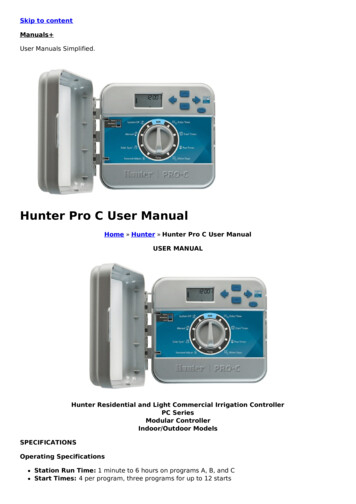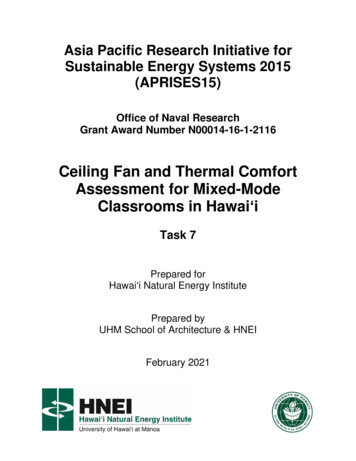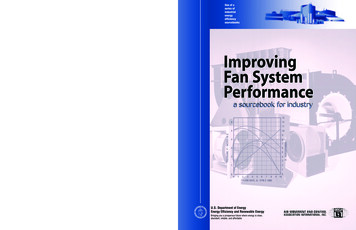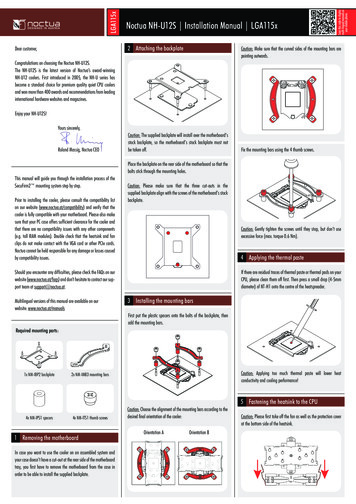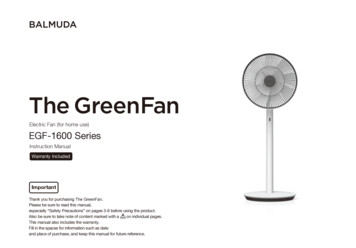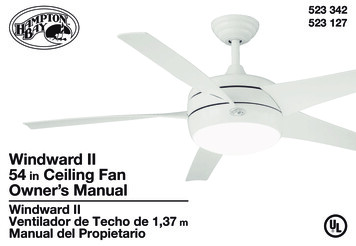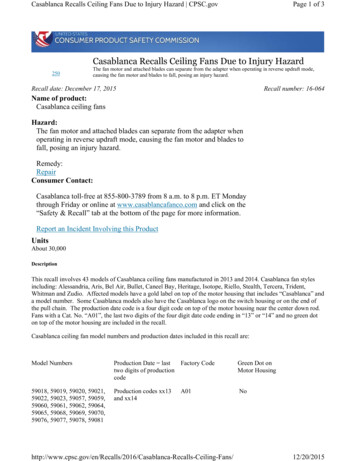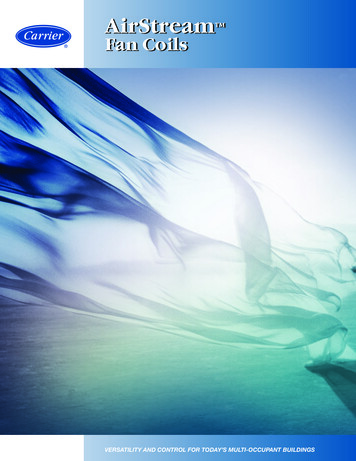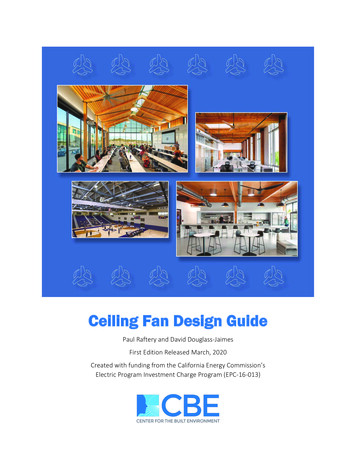
Transcription
Ceiling Fan Design GuidePaul Raftery and David Douglass-JaimesFirst Edition Released March, 2020Created with funding from the California Energy Commission’sElectric Program Investment Charge Program (EPC-16-013)
Table of ContentsABOUT THIS DESIGN GUIDE. 4Benefits Of Ceiling Fans . 5CEILING FANS AND THERMAL COMFORT . 10Human Body Thermoregulation . 10Factors of Thermal Comfort . 11How Ceiling Fans Help Meet Thermal Comfort Goals . 12ASHRAE Standard 55 Thermal Environmental Conditions For Human Occupancy . 12Thermal Comfort Calculations With Elevated Air Speed . 13CBE Thermal Comfort Tool . 14Ceiling Fans For Destratification In Heating Mode . 15ABOUT CEILING FANS . 17Fan Types . 17Blade Types And Configuration . 19Motor And Drive Types . 21FAN SELECTION, SIZING, AND LAYOUT . 22Understanding Fan Metrics . 22Uniformity Of Air Speeds . 30Selecting Fan Sizes And Determining The Layout . 33Fan Mounting Height And Clearances . 35Lighting . 37CONTROLS . 41User Interface . 41Types Of Control Automation . 43Additional Considerations For Choosing A Control Type . 43Integration With Building Controls And Sequences Of Operation . 44Airflow Direction . 45Occupant Interface and Education . 47Applications . 49CODES AND STANDARDS . 54Fire Code Requirements . 54Seismic Requirements . 55Ceiling Fan Design Guide 2020Page 2
Energy Code Considerations. 56ASHRAE 216 And Fan Testing Procedures . 57Costs . 58Modeling, Simulation and Energy Savings Estimation . 59CBE Ceiling Fan Design Tool . 61Acknowledgements . 64APPENDIX: DESIGN, SPECIFICATION, AND INSTALLATION CHECKLIST . 65APPENDIX: CASE STUDIES . 67APPENDIX: ADDITIONAL RESOURCES AND REFERENCES . 67Ceiling Fan Design Guide 2020Page 3
Figure 1: Bullitt Center, Seattle, WA, 2013. (Architecture:: Miller Hull, MEP: PAE Engineers,Photo: copyright Tim Griffith)ABOUT THIS DESIGN GUIDEThis guide enables architects, designers, and engineers to maximize the many benefits of integratingceiling fans into building systems. It introduces the advantages of using ceiling fans, describes how ceilingfans work, provides guidance and resources for designing spaces with ceiling fans and specifying ceilingfan products.Figure 2: Highlights of the design guide include thermal comfort benefits of ceiling fans, guidance for control and user interfacestrategies, a ceiling fan design and specification checklist, and an introduction to the CBE Ceiling Fan Design ToolCeiling Fan Design Guide 2020Page 4
Benefits Of Ceiling FansCeiling fans are more than just a basic amenity for residential applications. Increasingly, ceiling fans arefound in applications varying from industrial and warehouse applications to offices and high-endhospitality settings, and everything in between.The extensive use of ceiling fans in residential applications (over 80% of single family homes in the UnitedStates have at least one ceiling fan), as demonstrated in Figure 3 below, indicates their effectiveness insupporting thermal comfort, and occupant demand for controllable air movement.Figure 3: Number of fans per household by housing unit type, data source: U.S. Energy Information Administration 2015Residential Energy Consumption SurveyThis widespread applicability stems from the many benefits that ceiling fans can provide in interiorenvironments.The key benefits of ceiling fans are as follows: Thermal Comfort Improved Air Distribution Improved Perceived Air Quality HVAC First Cost Savings Energy SavingsThe following subsections describe each of these benefits in more detail.Thermal ComfortSimply stated, thermal comfort is an occupant’s satisfaction (“comfort”) with the perceived temperature(“thermal sensation”) of their environment. For centuries, humans have been using fans to help regulateCeiling Fan Design Guide 2020Page 5
thermal comfort. The reason for this is simple: in warm conditions there is generally less heat lost fromthe skin than in cooler conditions, and so people are at risk of warming up (the science of thermalcomfort is described in more detail below). Increased air movement across the skin carries away moreheat from the body (via convection and evaporation), and thereby restores comfort. Since the advent ofmechanical HVAC systems, building designers have largely focused on a single factor of thermal comfort:air temperature. However, modifying other factors of thermal comfort, such as air speed, changes how aparticular air temperature is perceived. Occupants near a ceiling fan will feel cooler than they would atthe same temperature in still air, similar to the phenomenon of “wind chill”, though the wind chill index istypically used for higher air speeds and colder temperatures than occur indoors. Similarly, when the airtemperature is warmer, occupants near a fan will feel more comfortable than they would in still airconditions.Improved Air DistributionIn addition to the thermal comfort benefits of increased air speeds, ceiling fans can also improve airdistribution, working in concert with the HVAC system to provide the desired thermal conditions moreconsistently throughout a space. When correctly designed and operated, ceiling fans support the HVACsystem to minimize temperature gradients within a space, providing more consistent temperature and airquality conditions throughout a space. This improved air distribution can be effective for both heatingand cooling scenarios. For example, ASHRAE Standard 62.1 – Ventilation for Acceptable Indoor Air Qualitylists a ventilation effectiveness of 0.8 for ceiling-supplied warm air systems (due to stratification of thewarm air near the ceiling), but adding ceiling fans in this scenario brings the ventilation effectiveness backto 1.0, or fully mixed condition, reducing the amount of outside air required.Improved Air QualityBy increasing air movement and improving air distribution in a space, ceiling fans also improve air quality.The increased air movement prevents the sensation of stale or stuffy air, and can help dissipate odors.One recent study has also documented a measurable air quality improvement from ceiling fans bydissipating CO2 and other exhaled pollutants that would otherwise gather near occupants in still airconditions. Large-scale studies of occupant survey data indicate that occupants would prefer more airmovement than they have, especially in conditions where occupants report feeling warm, as illustrated inFigure 4.Ceiling Fan Design Guide 2020Page 6
Figure 4: Occupant preference for more air movement (Data source: ASHRAE Global Thermal Comfort Database II)First Cost SavingsThe benefits described above—thermal comfort, improved air distribution, and improved air quality—achieve more than just increased occupant satisfaction, they can also help reduce first costs for HVACsystems. Using ceiling fans to more effectively distribute air throughout a space can reduce the extent ofdistribution ductwork and diffusers required to serve a zone. Additionally, if the same zone is designed toa slightly higher cooling setpoint due to the comfort cooling effect provided by the fans, this can alsoreduce the required latent and sensible cooling capacity of the HVAC system, providing first cost savingsto equipment and ductwork.Energy SavingsPerhaps most importantly, when implemented effectively as an integral component of a building’sthermal comfort strategy, ceiling fans can also result in significant energy savings by reducing the demandon the HVAC system. Although ceiling fans consume energy, the potential HVAC savings outweighs fanenergy use, typically by a factor ranging between 10 and 100 times. The primary energy saving derivesfrom thermal comfort benefits of ceiling fans, keeping occupants comfortable at higher temperatures andallowing for increased cooling setpoints. Effectively, a room with ceiling fans is thermally comfortableover a wider range of temperatures than a room without ceiling fans. This wider range of temperaturesreduces the cooling and fan energy consumption of the HVAC system. Counterintuitively, this wider rangeof temperatures also reduces heating energy consumption because when a space is warmer, it will takelonger to cool down to the heating setpoint. Lastly, when ceiling fans are used to provide air distribution,Ceiling Fan Design Guide 2020Page 7
reducing the extent of distribution ductwork and diffusers, they also help reduce HVAC fan energy byreducing the pressure drop in the air system. The section on Modelling, Simulation and Estimating EnergySavings discusses these effects in more.HistoryMethods of increasing air speeds to produce a cooling effect have been in use for centuries, from themost rudimentary handheld fans to more elaborate systems of sail-like fabric sheets or wooden panelsmounted to ceilings. Ceiling-mounted “punkah” fans, like those shown in Figure 5, were common inplaces like colonial India and the Antebellum South in the US, and were manually operated with ropespulled by servants or enslaved people. For a more localized cooling effect, there were also fan chairs likethe one used by George Washington, as shown in Figure 5.Figure 5: Historical fan technologies: fabric punkah fans at the Church of St. Francis in Kochi, India, circa 1795 (photo by AdamJones via Wikimedia Commons, creative commons license CC BY-SA 3.0), and a carved wood punkah fan at Melrose Plantation inNatchez, Mississippi, circa 1847 (photo courtesy The Punka Project); George Washington’s fan chair, circa 1790 (photo courtesyThe Punka Project); ceiling fans on a New York City subway car, circa 1910, at the New York Transit Museum (photo by Eric Fishervia Wikimedia Commons, creative commons license CC BY 2.0).Ceiling Fan Design Guide 2020Page 8
The first electric ceiling fan was invented by Philip Diehl in 1882, and the new technology quickly gained inpopularity. In the 1910s ceiling fans were even installed on New York City subway trains. However, withthe advent of mechanical cooling, and a concerted marketing effort to present air conditioners as the solemodern, healthy means of providing comfort cooling, ceiling fans waned in popularity and largelydisappeared from many types of indoor spaces.However, the inherent effectiveness of ceiling fans at cooling with air movement did not change, andtoday designers and engineers are increasingly recognizing the synergy of combining modern ceiling fanswith mechanical HVAC systems to improve comfort and energy efficiency in a broad range of applications.Ceiling fans should no longer be seen simply as a decorative element or residential amenity, but rather asan integral part of an effective thermal comfort system.Ceiling Fan Design Guide 2020Page 9
CEILING FANS AND THERMAL COMFORTIn this section we discuss the thermal comfort related effects of increased air movement using ceilingfans for cooling applications. We also discuss tools such as the CBE Thermal Comfort Tool to helpdetermine the right air speed and other factors for optimal thermal comfort. Figure 6 shows the coolingeffect–or how many degrees warmer the air temperature can be to provide the same level of thermalcomfort–associated with increased air speeds. This figure also highlights that the design air speeds underdiscussion in this guide are well below the air speeds that a person experiences every day. An exampledesign speed of 0.5 m/s or 100 fpm, equal to approximately 2 C or 4 F cooling effect, is approximatelyhalf the air speed that a person experiences just from the relative motion of walking slowly through stillair conditions.Figure 6: Cooling effect of increased air speed1Human Body ThermoregulationAs discussed above, thermal comfort is an occupant’s satisfaction (“comfort”) with the perceivedtemperature (“thermal”) of their environment. This satisfaction depends on how much heat is released orretained by the occupant’s body. Heat transfer to and from the body occurs in four ways. These are listedin order of decreasing amount of heat transfer under standard conditions: Radiation - heat transfer via electromagnetic waves between objects that are not touching. Themost familiar form of radiant heat transfer is the radiant energy from the sun. However,1for a ‘typical’ office worker in cooling conditions, according to ASHRAE 55:2017 at an operative temperature of76F, 50% relative humidity, 0.6 clo, 1.13 met.Ceiling Fan Design Guide 2020Page 10
longwave radiation to surrounding surfaces is also a primary mechanism of heat loss from thehuman body. Convection – heat transfer between a solid source and a fluid, in this case between skin and air, isof similar magnitude to heat transfer by radiation under standard conditions (still air). Theamount of heat loss from the body through convection depends on the air speed, as that directlyaffects the convective heat transfer rate from the skin. Still air acts like an insulator, withconvection only occurring due to the buoyancy driven effect driven by the temperaturedifference between skin (or clothes) and the surrounding air. As air speed increases, this givesrise to forced convection, allowing for more heat to be released. Evaporation - heat loss through the phase change of sweat from liquid to vapor. The phasechange requires energy in the form of heat extracted from the skin, cooling the body when sweatevaporates. The rate of evaporation depends on the humidity of the surrounding air, with drierair able to absorb more moisture through evaporation. Conduction - heat transfer between objects in contact. The cooling sensation of holding a colddrink or the warming sensation of touching a hot surface are both examples of heat transferthrough conduction. Conduction is typically responsible for the smallest share of heat loss fromthe body.Figure 7: Human body heat rejectionFactors of Thermal ComfortASHRAE Standard 55 – Thermal Environmental Conditions for Human Occupancy identifies six factors thataffect thermal comfort: Metabolic Rate - the rate of transformation of chemical energy into heat and mechanical work,based on the level of activity. For example, the body generates more heat while walking thanwhile sitting still. Clothing Insulation - the insulating effect of clothing preventing heat loss from the body. Forexample, shorts and a short-sleeve shirt will allow more heat loss from the body than pants and aheavy sweater.Ceiling Fan Design Guide 2020Page 11
Air Temperature - the temperature of air at a certain point. Mean Radiant Temperature - the average temperature of the surfaces surrounding a certainpoint, weighted by how large an angle that surface makes when viewed from that point. Air velocity or speed - the velocity or speed of air at a certain point. Humidity - how much moisture the air contains.How Ceiling Fans Help Meet Thermal Comfort GoalsCeiling fans increase air speed, and increased air speed accelerates two of the heat transfer mechanismsdescribed above: convection and evaporation. Thus, ceiling fans accelerate heat loss from the body,providing a cooling sensation. The cooling sensation from increased air speed allows the body to maintainthermal comfort at higher air temperatures than what would be comfortable in still air.In addition to providing comfort at increased temperatures, ceiling fans are capable of providinginstantaneous comfort effects that thermostat adjustments cannot. A thermostat and HVAC system thatconditions the whole room generally takes 15 minutes or longer before the occupant will perceive achange in their thermal environment. However, a ceiling fan has an almost instantaneous effect. If anoccupant feels too warm, turning on or increasing the speed of a ceiling fan instantly provides a coolingsensation. Similarly, if an occupant is too cool and the fan is operating, reducing the ceiling fan speed orturning it off instantly provides a warmer sensation. Ceiling fans are also ideally suited to providingadaptive or transitional comfort for changing human comfort conditions. Adjusting ceiling fan speeds canhelp accommodate the natural fluctuations in body temperature and comfort preferences throughoutthe day. Similarly, the adjustable nature of ceiling fans can provide enhanced thermal comfort duringtransitional moments, such as the changing comfort needs when transitioning from an active metabolicrate event (for example, after walking from a meeting in a different part of the building, or arriving in towork from a morning commute) to a resting metabolic rate (such as sitting at a desk in an office), orsimply due to different personal thermal comfort requirements of occupants in the same physical space.In order to determine how much air movement is needed for thermal comfort and occupant satisfaction,we can look at ASHRAE Standard 55 and the CBE Thermal Comfort Tool.ASHRAE Standard 55 Thermal Environmental Conditions For Human OccupancyASHRAE Standard 55 – Thermal Environmental Conditions for Human Occupancy identifies factors(discussed above) that may affect thermal comfort in an indoor environment and how occupantsatisfaction is affected when these factors are changed. The standard also provides methods todetermine optimal values for each of the factors to create a comfortable environment.Standard 55 outlines both a graphical and analytical method to determine acceptable thermal comfortzones. In the graphical comfort zone method (Section 5.3.1 of the standard), comfort zones are shown ona graph based on occupant metabolic rates and clothing insulation levels. By using space conditions, suchas temperature and humidity, it can be determined whether the space falls within the occupants’ comfortzone. This method can only be used however when the occupants’ metabolic rates and clothing insulationlevels are within a certain range and does not account for changes in comfort zone due to elevated airspeed.Ceiling Fan Design Guide 2020Page 12
The analytical comfort zone method (Normative Appendix B) can be used for a wider range of occupantcharacteristics. The analytical comfort method calculates a predicted mean vote (PMV) based on acombination of thermal comfort factors. PMV is an index that predicts the average vote of thermalsensation in a large group of people on scale from –3 (cold) to 3 (hot), where a score of 0 would beconsidered perfectly comfortable. Using this method, a PMV between –0.5 and 0.5 must be obtained tobe ASHRAE 55 compliant.ASHRAE 55-2017 Addendum C introduces comfort control classification levels (CCCLs) into the standard,where a lower CCCL number indicates an improved level of occupant comfort. This captures thebeneficial effects of increased opportunities for local and group level control of thermal comfort.Table 1: ASHRAE 55-2017 Addendum C comfort control classification levels (CCCLs)CCCLRequired Control Measure(s)1Personal control of two ormore2Personal control of oneInformative Examples Meeting CCCL Private office with a ceiling fan and an occupantadjustable thermostat Shared office with desktop fans and seat warmers foreach occupant Private office with an occupant adjustable thermostat Shared office with a desktop fan for each occupant3Multi occupant control of twoor more Shared office with an occupant adjustable thermostatand ceiling fan control4Multi occupant control of one Shared office with an occupant adjustable thermostat5No occupant control Shared or private office with an un-adjustablethermostat or no thermostatThermal Comfort Calculations With Elevated Air SpeedStandard 55 also provides a method called The Elevated Air Speed Comfort (Section 5.3.3. of standard) tocalculate thermal comfort in situations of elevated airspeed. This method uses a combination of theAnalytical Comfort Zone Method combined with the Standard Effective Temperature (SET) method(Normative Appendix D of standard). Since increasing air speeds has a cooling effect, the methodcalculates adjusted air and radiant temperatures according to how occupants are expected to feel underincreased air speed conditions to calculate a new PMV value. The “Standard Effective Temperature” (SET)output translates the 6 thermal comfort factors (from above) into a single temperature equivalent. TheSET provides a single metric that can be compared across a variety of comfort conditions.Cooling effect is also used to calculate the Cooling Fan Efficiency (CFE). CFE is defined in ASHRAE Standard216, currently under development, as the ratio of the cooling effect to the input power of the fan. CFEgives people a standardized way to compare how much cooling a fan provides when consuming the sameamount of energy.Ceiling Fan Design Guide 2020Page 13
CBE Thermal Comfort ToolA helpful tool to find comfort zones at elevated air speeds according to ASHRAE 55 methodology is theCBE Thermal Comfort Tool, an online tool developed by The Center for the Built Environment at theUniversity of California at Berkeley.The user enters temperature, air speed, humidity, metabolic rate and clothing level into the tool tocalculate results including PMV, SET, and ASHRAE 55 compliance as well as generating the graph below inFigure 8. The blue shaded area represents the ASHRAE 55 compliant comfort zone while the red markshows where the user inputs are relative to the comfort zone. The tool also supports the internationalcomfort standard ISO EN 16798.Figure 8: Example screenshot of the CBE Thermal Comfort Tool, showing user inputs, psychometric chart, and resultsThe CBE Thermal Comfort Tool also takes into account elevated air speeds. As the air speeds increase, therange of acceptable temperatures increases, and the blue shaded area shifts to the right. Using higher airspeeds allows the user to be ASHRAE 55 compliant at higher cooling temperature setpoints. Note thatStandard 55 has a maximum average air speed permitted in the case that occupants do not have controlover the system (0.8 m/s or 160 fpm). This can be specified as an input in the Thermal Comfort Tool aswell. To support this functionality, users can also select the “air speed vs. operative air temperature”mode from the drop down menu above the chart to view the comfort range and results in terms of airspeed and temperature, as shown in Figure 9, below.Ceiling Fan Design Guide 2020Page 14
Figure 9: Example screenshot of the CBE Thermal Comfort Tool showing air speed vs. operative air temperature modeCeiling Fans For Destratification In Heating ModeIn addition to directly cooling occupants, ceiling fans also effectively mix the air in a space, which hasseveral applications. The most common of these applications is where the temperatures in a space arestratified, with much warmer air close to the ceiling and cooler air near the floor. This typically occurs inspaces with high ceilings or where the heating equipment has a relatively high discharge temperature. Inthese conditions, ceiling fans can mix the air in the space such that the temperature at the floor (andclose where the thermostat is located) is close to the average temperature in the space. This can saveenergy and also improve occupant comfort. Ceiling fans can run in either direction to achieve this mixing,though they will use more power to achieve the same mixing effect when operating in reverse (moving airupward) than forwards (moving air downward). Note that when destratifying, the space is typicallyoperating in heating mode and operating at the lower end of the range of temperatures that define thethermal comfort zone. As such it is very important to maintain very low air speeds in the occupied zone inorder to avoid the sensation of draft. Depending on the specific conditions, the occupant locations, andthe minimum speed capabilities of the fan, running the fan in forward or reverse may be better able toachieve this goal.Ceiling Fan Design Guide 2020Page 15
Figure 10: Ceiling fans for destratificationCeiling Fan Design Guide 2020Page 16
Figure 11: Large-diameter ceiling fans at Barrie North School library. (Photo copyright Big Ass Fans)ABOUT CEILING FANSThe following sections describe the different types of ceiling fans, and the features that differentiateceiling fan models.Fan TypesAs part of the “Uniform Test Method for Measuring the Energy Consumption of Ceiling Fans”2 the USDepartment of Energy (DOE) defines a variety of ceiling fans types. For the purpose of this guide,discussions focus on two main ceiling fan types: Standard ceiling fan – any ceiling fan with a diameter greater than 18 inches but no more than 7 feet, andwith the lowest point of the fan blades more than 10 inches below the ceiling. A standard ceiling fan notexceed the limits outlined in Table 2 below. Large-diameter ceiling fan – any ceiling fan that is greater than seven feet in diameter. These are often alsoknown as High Volume Low Speed (HVLS) fans.In addition to these two primary types of ceiling fans, the DOE defines several other fan types that arecommonly used, many of which fall under the category of small-diameter ceiling fan. Small-diameter ceiling fan – any ceiling fan that is more than 18 inches in diameter but less than or equal toseven feet in diameter, and with an airflow of at least 1,840 CFM and a rotational speed of more than 90RPM at its highest speed.oHigh-speed small-diameter ceiling fan – any small-diameter ceiling fan that has a blade thicknessof less than 3.2 mm at the edge or a maximum tip speed greater than the applicable limit specifiedin Table 2 below.2Appendix U to Subpart B of Part 430 – Uniform Test Method for Measuring the Energy Consumption of CeilingFans, Code of Federal Regulations, Title 10, Chapter II, Subchapter D. https://www.ecfr.gov/cgibin/retrieveECFR?gp &SID 723eddbb09c4b80
on the HVAC system. Although ceiling fans consume energy, the potential HVAC savings outweighs fan energy use, typically by a factor ranging between 10 and 100 times. The primary energy saving derives from thermal comfort benefits of ceiling fans, keeping occupants comfortable at higher temperatures and allowing for increased cooling setpoints.
